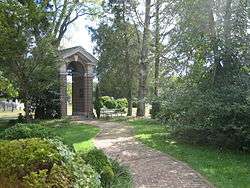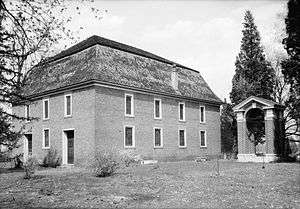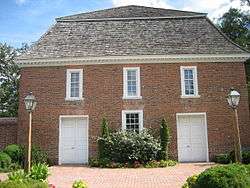St. Barnabas' Episcopal Church, Leeland
| New Brick Church St. Barnabas Church | |
|---|---|
 | |
| Basic information | |
| Location |
14705 Oak Grove Road Upper Marlboro, Maryland |
| Geographic coordinates | 38°52′30.61″N 76°45′30.26″W / 38.8751694°N 76.7584056°W |
| Affiliation | Episcopal |
| Website | http://www.stbarnabas.net |
| Architectural description | |
| Architect(s) |
Christopher Lowndes, Walter Macomber[1] |
| Architectural style | Georgian Colonial[1] |
| Specifications | |
| Direction of façade | west |
| Length | 60 feet |
| Width | 46 feet |
| Materials | brick, wood shingle roof |
St. Barnabas Church, also known as St. Barnabas' Episcopal Church, Leeland, was built in Leeland, Maryland and was established in 1704 as the parish church of Queen Anne Parish which had been established that same year. Because of its location in one of the richest tobacco-producing regions in Colonial Maryland, the small church has been a cultural hub for southern Maryland from early colonial times, through the American Revolution, Civil War, and Reconstruction. The church holds some highly significant art[2][3] and was the scene of a fiery anti-revolutionary showdown that was close to erupting in violence.[4]
History
On December 19, 1704, St. Paul’s Parish, one of the 30 original parishes of the established Anglican Church in the Province of Maryland,[5] was divided by the Maryland General Assembly and the northern part became Queen Anne Parish, while the southern part remained St. Paul's.
An Act for the Division of St. Paul's Parish in Prince George's County
Lib. LL. N° 3. fol. 213.
(1.) The said Parish to be divided.
(2.) The Division Lines to begin with the dividing Branches of Patuxent River, and to run with the Western Branch, to a Branch called Cabin-Branch, by the Plantation of a certain Edward Willet, and so with the Cabin-Branch, to the Head thereof: And the Southernmost part to be adjudged to be St. Paul's Parish.
(3.) The said St. Paul's Parish to be further bounded and divided by the Ridge between Patuxent and Patowmack; and the Eastern Side of the said Ridge, and the Northernmost Part of the Western Branch, to be adjudged a new and distinct Parish, by the Name of Queen-Anne's Parish, with Power to elect proper Officers, and enjoy all the Advantages, Privileges and Benefits of a compleat and entire Parish.[6]
The original St. Paul's Parish had contained a small log chapel,[1] in its northeast sections, on 2 acres (8,100 m2) of land owned by John and Mary Duvall.[7][8] With this act, the chapel became a full-fledged congregation to meet the needs of the growing population in the area, creating the first St. Barnabas church.
Shortly thereafter, in 1706, the colonial Maryland Legislature authorized surveying and laying out of nearby "Queen Anne Town and Marlborough Town" bringing further development to the area.[9] In 1708, Rev. Jonathan White came to Queen Anne Parish as Rector.[10]
Old Brick Church
Col. Henry Ridgley, a prominent land-owner in Anne Arundel County and Prince George's County, was one of the first vestrymen of the parish, and pledged £10 towards the construction of a brick church in 1709 and left another £20 upon his death in 1710.[11] The log structure was replaced in 1710 by the first small brick church, which was the second St. Barnabas Church on the site and rather small. It is now referred to as the old Brick Church.[1]
White remained at St. Barnabas until 1717, at which time he either died or was removed from the parish.[10]
Henderson's Chapel and Holy Trinity
In 1713, Col. Ridgley's widow, Mary (née Duvall, née Stanton, and who would later become Henderson's wife) built a chapel on her own land near her residence. On December 17, 1717, Reverend Jacob Henderson was appointed as rector of Queen Anne Parish. About that time he acquired numerous parcels of property through his marriage to the twice widowed, Mary Ridgely.[12] In 1737, Henderson gave 4 acres (16,000 m2) of land for the use of Queen Anne's Parish called "the Glebe whereon there is a Chapple now standing." That chapel had been built for the convenience of northern part of the parish and was known as Henderson's Chapel or Forest Chapel. Almost 100 years later, in 1836 Henderson's Chapel became an independent congregation, Holy Trinity Episcopal Church.[9][10][13]
Henderson died on August 27, 1751 after 34 years of service at St. Barnabas.[10]
Affluence and a new Brick Church
Because of its location in one of the richest tobacco-producing regions in Colonial Maryland, its rectorship was one of the most highly prized assignments in the Anglican Church in the province. In 1771, Jonathan Boucher came to St. Barnabas,[2] having served as Rector of St. Anne's in Annapolis since 1768.[14]

During this period, numerous dignitaries visited the church, including George Washington and his family, together with Royal Governor of Maryland Robert Eden, on October 4, 1772.[15]
By 1772 the congregation had outgrown the original St. Barnabas church building and commissioned Christopher Lowndes “to make, erect, build, and set up a new Brick Church near the place where the Old Brick Church in said parish now stands, to contain sixty feet in length and forty-six feet in width.”[7]
As recorded in the Prince George's County Historic Site Summary:
"St. Barnabas' Church at Leeland, Maryland is a two-story Georgian Colonial brick church building three bays by four bays, built of brick laid in Flemish bond; It has a molded water table. There are entrances in the first and third bays of the principal three-bay west facade, through double doors. The jambs and soffits of the doors are panelled. Windows on the first story are 6/9 double hung sash, while those on the second story are narrower four over six lights. The roof is hip-on-hip, covered with wood shingle. The narrow wood cornice is punctuated with dentil modillions and defined by bed and crown moldings. Inscribed in one of the stretchers which frame the central first story window on the east facade is "AD July 3, 1774."[1]
Revolutionary hostilities
| Wikiquote has quotations related to: Jonathan Boucher at St. Barnabas |
Boucher was an ardent Tory and opposed the revolution from the pulpit. For months, he preached with a pair of loaded pistols beside him.[2] In a fiery farewell sermon at St. Barnabas in 1775, he declared to a hostile crowd of 200, that "no power on earth should prevent him from praying and shouting God Save the King." At the conclusion of the sermon, he seized the leader of the crowd, Osborn Sprigg of Northampton, Maryland, (uncle and adopted father of future Governor Samuel Sprigg)[4] and with pistol in hand, they walked together to Boucher's horse. Both men were allowed to leave without harm. Boucher then fled to England.[2]

Nineteenth Century
In the 1850s, the church was renovated and Victorianized, with stained glass windows replacing the original colonial clear glass lights.[1]
Recent times
In 1971, this “new Brick Church,” was in need of repair and was carefully and authentically restored to its original colonial form as built by Lowndes including clear windows along with the addition of a new chapel under the direction of architect, Walter Macomber.[1][7] The restored church was dedicated in October 1974.[1]
Queen Anne School
In 1964 St. Barnabas’ Church founded Queen Anne School, a private, Episcopal-affiliated, co-educational day school for grades 7-12 (now 6-12), located on a 50-acre (20 ha) campus adjacent to the new Brick Church.[16] Although the school was owned by St. Barnabas’ Church, it functioned as an independent educational institution, certified by the Association of Independent Maryland Schools.[7] The school closed after the 2010-2011 school year and the 50-acre campus is now leased and operated by Imagine Foundations Public Charter School.[17]
Current use

St. Barnabas Church is an active parish in the Episcopal Diocese of Washington. Beginning January 15, 2015, the Rector is the Rev. Robyn E Franklin-Vaughn.[18]
Art
The first recorded public art commission in the American colonies, The Last Supper by Gustavus Hesselius, commissioned in October 1721 is displayed on the choir gallery of the church.[2][3][19] Before this, most painting in the new world had been portraits. The Last Supper was the first significant American painting to depict a scene.[2]
The painting which measures 35 inches (890 mm) by 117 1/2 inches[19] was commissioned for the first Brick Church and remained there until the present structure was built. It disappeared during the construction of the new Brick Church and did not surface again until it was discovered in a private collection in 1848[2] or 1914, when Charles Henry Hart identified it,[19] depending on which source one follows.
It was on loan by Rose Neel Warrington for a period at the Philadelphia Museum of Art and at the American Swedish Historical Museum[2] as well as the Exhibition of Early American Paintings at the Brooklyn Institute of Arts and Sciences in 1917 and the Wilmington Society of the Fine Arts.[19]
The painting was willed once again to St. Barnabas upon Warrington's death.[2]
See also
References
- 1 2 3 4 5 6 7 8 St. Barnabas Episcopal Church, Maryland Historical Trust, Historic Sites Survey # PG:79-59 (web database), Maryland State Archives, retrieved 2007-09-27
- 1 2 3 4 5 6 7 8 9 Virta, Alan (1984). Prince George's County: A Pictorial History. Norfolk, Virginia: The Donning Company. pp. 67–69.
- 1 2 "Maryland ArtSource - Artists - Gustavus Hesselius". The Baltimore Art Research & Outreach Consortium (BAROC). n.d. Retrieved 2007-12-04.
- 1 2 Buchholz, Henrich Ewald (1908). Governors of Maryland from the Revolution to the Year 1908 (PDF). Baltimore: Wiliams & Wilkins Company. p. 92.
- ↑ Middleton, the Rev. Canon Arthur Pierce, Ph.D., Anglican Maryland, 1692-1792, Virginia Beach: The Donning Company, 1992, pp. 5, 93-94, ISBN 0898658411
- ↑ "1704 CHAP. XCVI, An Act for the Division of St. Paul's Parish in Prince George's County". Bacon's Laws of Maryland Volume 75, Page 161. Maryland State Archives. 2006-07-31. Retrieved 2007-12-07.
- 1 2 3 4 St. Barnabas’ Episcopal Church (PDF), St. Barnabas’ Episcopal Church, retrieved 2007-07-18
- ↑ Williams, T. J. C.; Folger McKinsey (1979) [1910]. History of Frederick County, Maryland, Vol 2. L.R. Titsworth & Co./Clearfield Co. p. 948. ISBN 0806380128.
- 1 2 Baltz, Shirley Vlasak (1984). A Chronicle of Belair. Bowie, Maryland: Bowie Heritage Committee. pp. 4–9. LCCN 85165028.
- 1 2 3 4 Sprague, William Buell (1859). Annals of the American Pulpit; or Commemorative Notices of Distinguished American Clergymen of Various Denominations From the Early Settlement of the Country to the Close of the Year Eighteen Hundred and Fifty Five, Volume V. New York: Robert Carter & Brothers. pp. 34–38.
- ↑ Baltz, Shirley Vlasak (2005). Belair From the Beginning. Bowie, Maryland: City of Bowie Museums. p. 6.
- ↑ Warfield, Joshua Dorsey (July 1905). The Founders of Anne Arundel And Howard Counties, Maryland. Baltimore, Maryland: Kohn & Pollock. p. 106. ISBN 0806379715.
- ↑ "A History of Holy Trinity Episcopal Church". Retrieved 2007-09-25.
- ↑ Sprague, William Buell (1859). Annals of the American Pulpit; or Commemorative Notices of Distinguished American Clergymen of Various Denominations From the Early Settlement of the Country to the Close of the Year Eighteen Hundred and Fifty Five, Volume V. New York: Robert Carter & Brothers. pp. 211–212.
- ↑ "About Us: St. Barnabas' Episcopal Church, Queen Anne Parish" (PDF). St. Barnabas’ Episcopal Church. 2007-06-22. Retrieved 2008-02-09.
- ↑ About Our School (PDF), Queen Anne School, 2006, retrieved 2007-09-27
- ↑ Waite, Andrew (19 April 2011). "Imagine to take over Queen Anne School in Upper Marlboro". Maryland Gazette. Retrieved 12 December 2011.
- ↑ "St. Barnabas' Episcopal Church, Leeland website".
- 1 2 3 4 Marceau, Henri (1931), "Bulletin of the Pennsylvania Museum, Vol. 26, No. 142, Part 1", Bulletin of the Pennsylvania Museum, Pennsylvania Museum of Art, 26: 10–13, doi:10.2307/3794543, ISSN 0891-3609, JSTOR 3794543